Table of Contents
Advertisement
Quick Links
Advertisement
Table of Contents

Summarization of Contents
Preface
Audience
This publication is for network administrators who install, configure, and maintain Cisco Nexus switches.
Document Conventions
Command descriptions use the following conventions: bold, italic, square brackets, and braces.
Related Documentation
The entire Cisco Nexus 9000 Series switch documentation set is available at the following URL.
Documentation Feedback
To provide technical feedback on this document, or to report an error or omission, please send your comments to nexus9k-docfeedback@cisco.com.
Obtaining Documentation and Service Request
For information on obtaining documentation, using the Cisco Bug Search Tool (BST), submitting a service request, and gathering additional information.
New and Changed Information
New and Changed Features
This table summarizes the new and changed features for the Cisco Nexus 9000 Series NX-OS IP Fabric for Media Solution Guide, Release 7.0(3)14(2).
Overview of Cisco's IP Fabric for Media Solution
About the IP Fabric for Media Solution
Today, the broadcast industry uses a serial digital interface (SDI) router and SDI cables to transport video and audio traffic.
Cisco Nexus 9200 Series Switches
The following Cisco Nexus 9200 Series switches are used to transport video and audio traffic through the IP fabric.
IP Fabric for Media Topology
Cisco's IP fabric for media solution supports a spine-leaf topology that consists of one spine switch and up to nine leaf switches.
Failure Handling
Cisco's IP fabric for media solution supports deterministic failure handling. When a link fails, the following actions occur:
Benefits of the IP Fabric for Media Solution
Cisco's IP fabric for media solution provides the following benefits: Replaces specialized hardware (SDI routers) with a general-purpose switching infrastructure.
Setting Up the IP Fabric for Media
Determining Leaf Switch Requirements
The number and types of leaf switches required in your IP fabric depend on the number and types of endpoints in your broadcasting center.
Determining Achievable Flows
Use this equation to determine the number of possible flows in your IP fabric: Total Bandwidth ÷ Flow Size = Number of Achievable Flows.
Configuring IP Fabric for Media
Prerequisites
Cisco's IP fabric for media solution has the following prerequisites: The Cisco Nexus 9200 Series switches must be running Cisco NX-OS Release 7.0(3)14(2) or a later release.
Guidelines and Limitations
Cisco's IP fabric for media solution has the following guidelines and limitations: Only the Cisco Nexus 9236C and 9272Q can be spine switches.
Configuring NBM
After you have set up the IP fabric, you must enable the NBM feature and set the flow bandwidth on the spine switch and each leaf switch.
Configuring PTP for Media
Cisco's IP fabric for media solution supports the following IEEE 1588 PTP profiles: Audio Engineering Society 67 profile (AES67).
Configuration Example
The following example shows how to configure an IP network that supports 3G HD video broadcast traffic.
Chapter 4 Related Documentation
Lists related topics and their corresponding document titles for further reference.














Need help?
Do you have a question about the Nexus 92160YC-X and is the answer not in the manual?
Questions and answers